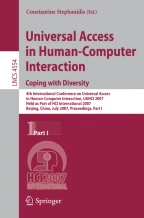Abstract
The results of examining a scanning user interface implementation with command inputs in the form of head gestures for a rehabilitation robot using Fitts’ law variations and comparing these with a servo eye tracking model are made. Calculations show that the movement time prediction is more accurate in this case using the servo eye model. The response from the linearised eye model predicts that there is a minimum scanning distance that can be used and minimum spacing between commands display.
Chapter PDF
Similar content being viewed by others
References
Parsons, B.N: The design and Evaluation of an interface and control system for a scariculated rehabilitation robot arm. PhD thesis, School of Engineering Systems, Middlesex University (2001)
Keates, S., Clarkson, P.J., Robinson, P.: Developing a methodology for the design of accessible interfaces. In: Proc. 4th ERCIM workshop, pp. 1–15 (1998)
Lesher, G.W., Higginbotham, D.J., Moulton, B.J.: Techniques for automatically updating scanning delays. In: Proc. RESNA Conf., pp. 85–87 (2000)
Parsons, B., White, A., Warner, P., Gill, R.: Validation methods for an accessible user interface for a rehabilitation robot. UAIS 5(3), 306–324 (2006)
MacKenzie, I.S.: Motor Behavior Models for Human-Computer interaction Chapter 3 in HCI Models. In: Carroll, J.M. (ed.) Theories and Frameworks, pp. 35–40. Morgan Kaufmann, San Francisco (2003)
Langolf, G.D., Chaffin, D.B., Foulke, J.A.: An Investigation of Fitts’ Law using a wide range of movement amplitudes. J. Motor Behavior 8(2), 113–128 (1976)
Jagacinski, R.J., Repperger, D.W., Ward, S.L., Moran, M.S.: A test of Fitts’ Law with Moving Targets. Human Factors 22(2), 225–233 (1980)
Hwang, F., Keates, S., Langdon, P.M., Clarkson, P.J.: Movement time prediction for tasks assisted by Force-feedback. In: Chapter 15 in Designing a more inclusive world ed Keates, Springer, Heidelberg (2004)
Phillips, C.A.: Human Factors Engineering. Wiley, New York (2000)
McRuer, D.T., Jex, H.R.: A Review of Quasi-Linear Pilot Models. IEEE Trans. Human Factors in Electronics HFE-8(3), 231–249 (1967)
Robinson, G.H.: Dynamics of the eye and head during movement between displays: A qualitative and Quantitive Guide for Designers. Human Factors 23(3), 343–352 (1979)
Young, L.R., Stark, L.: ariable Feedback Experiments Testing a Sampled Data Model for Eye Tracking Movements. IEEE Trans. On Human Factors in Electronics 4, 38–51 (1963)
Churchland, M.M., Lisberger, S.G.: Experimental and Computational Analysis of Monkey Smooth Pursuit Eye Movements. J. Neurophysiology 6, 741–759 (2001)
MacKenzie, I.S., Jusoh, S.: An evaluation of two input devices for remote pointing. In: Proc. 8th IFIP Working Conf. on Engineering for Human –Computer Interaction, pp. 235–249 (2001)
Sears, A., Lin, M., Karimullah, A.S.: Speech-based cursor control: understanding the effects of target size, cursor speed and command selection. UAIS 2, 30–43 (2002)
Author information
Authors and Affiliations
Editor information
Rights and permissions
Copyright information
© 2007 Springer-Verlag Berlin Heidelberg
About this paper
Cite this paper
White, A.S., Prior, S. (2007). Usability Design of a Scanning Interface for a Robot Used by Disabled Users. In: Stephanidis, C. (eds) Universal Acess in Human Computer Interaction. Coping with Diversity. UAHCI 2007. Lecture Notes in Computer Science, vol 4554. Springer, Berlin, Heidelberg. https://doi.org/10.1007/978-3-540-73279-2_116
Download citation
DOI: https://doi.org/10.1007/978-3-540-73279-2_116
Publisher Name: Springer, Berlin, Heidelberg
Print ISBN: 978-3-540-73278-5
Online ISBN: 978-3-540-73279-2
eBook Packages: Computer ScienceComputer Science (R0)
